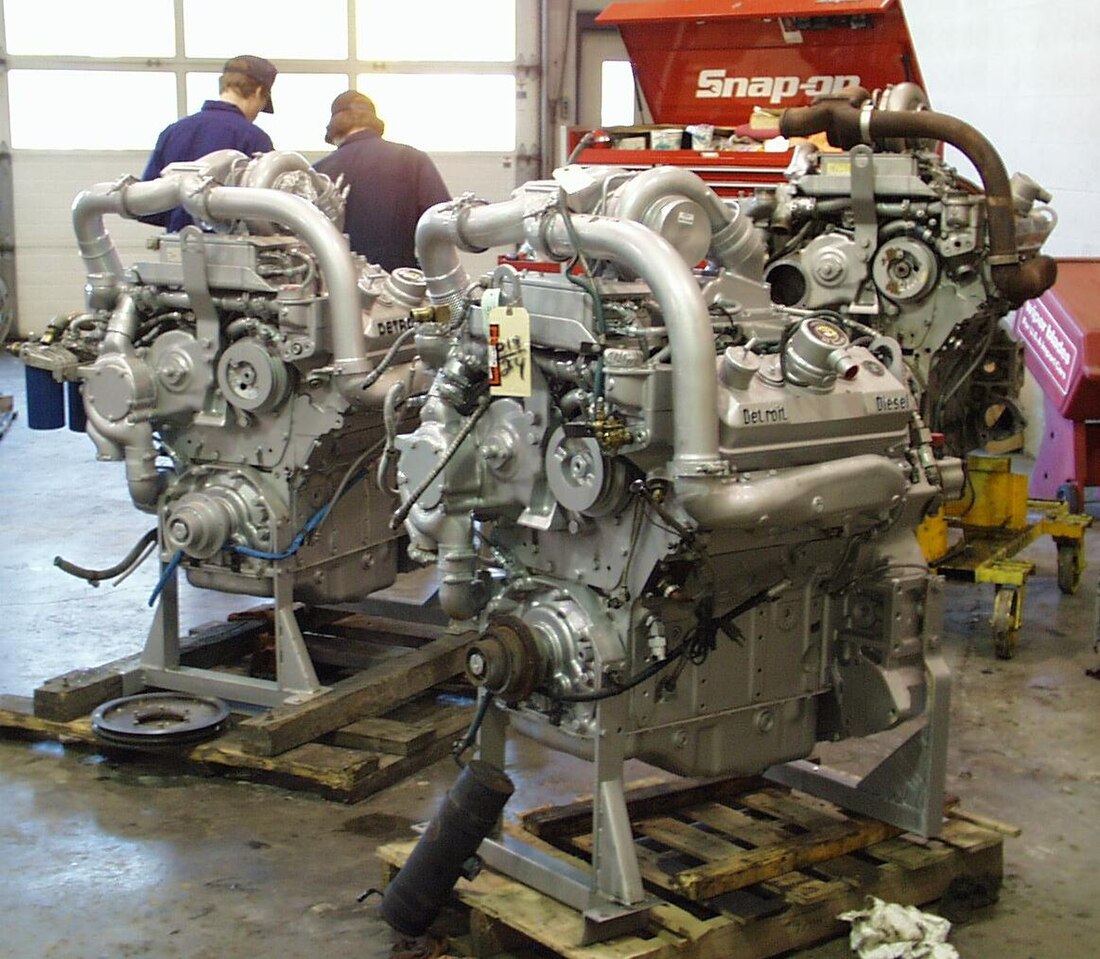Top Qs
Timeline
Chat
Perspective
Detroit Diesel Series 92
Reciprocating internal combustion engine From Wikipedia, the free encyclopedia
Remove ads
The Detroit Diesel Series 92 is a two-stroke cycle, V-block diesel engine, produced with versions ranging from six to 16 cylinders. Among these, the most popular were the 6V92 and 8V92, which were V6 and V8 configurations of the same engine respectively. The series was introduced in 1974 as a rebored version of its then-popular sister series, the Series 71. Both the Series 71 and Series 92 engines were popularly used in on-highway vehicle applications.
Remove ads
History
Summarize
Perspective
The Series 92 engines were introduced in 1974.[8] Compared to the Series 71 engines they were derived from, the Series 92 featured a larger bore of 4.84025 ± 0.00125 in (122.942 ± 0.032 mm) and an identical stroke of 5 in (130 mm) for a nominal displacement per cylinder of 92 cu in (1,510 cc), from which the Series 92 derives its name.
While the basic mechanics of the 92 series indicated superior performance and durability, early prototypes were challenged by breakdowns resulting from the torque inherent in the design. Carl Kamradt, the senior engineer in Detroit Diesel Allison's E5, or Experimental Department, was responsible for working through the practical applications of the engine, resulting in the 92 Series becoming the favored choice for applications requiring high torque and dependability. Upon Mr. Kamradt's retirement in 1984, the E-5 division was eliminated as the 92 Series ran its course. In the 1980s and early 1990s, the Series 92 was used as a major bus engine in North America. It was also available for several other applications: Trucks, buses, motor homes, construction, fire trucks/apparatus, industrial equipment, several military vehicles, aircraft and marine applications.
The Series 92 left the market in the summer of 1995 and the four stroke Detroit Diesel engine Series 60 was introduced as a replacement.
Remove ads
Features and specifications
Summarize
Perspective
- 9.0 litre (V6), 12.1 litre (V8), 18.1 litre (V12) and 24.1 litre (V16)
- Power ratings ranging from 253 to 950 horsepower (189 to 708 kW)
- Supported the DDECI, DDECII, DDECIII and DDECIV.
- Gear
Power output specifications (6V92)
- 775 ft⋅lbf (1,051 N⋅m) @ 1200 rpm; 253 horsepower governed at 2100 rpm
- 816 ft⋅lbf (1,106 N⋅m) @ 1200 rpm; 277 horsepower governed at 2100 rpm
- 957 ft⋅lbf (1,298 N⋅m) @ 1300 rpm; 300 horsepower governed at 2100 rpm
- 1,020 ft⋅lbf (1,380 N⋅m) @ 1300 rpm; 335 horsepower governed at 2100 rpm
Power output specifications (8V92)
- 983–1,242 lb⋅ft (1,333–1,684 N⋅m) @ 1400 rpm; 360-435 horsepower governed at 1965-2100 rpm
Remove ads
Model number
Summarize
Perspective
The model number indicates the basic configuration of the engine.[9]: 7 The model designator consists of the number of cylinders (6, 8, 12, or 16), the block layout (V), engine series (92), and a lettered suffix which provides information about forced induction (T for turbocharged, A for aftercooled), so for instance, an 8V92TA designates a Series 92 V8 engine that is turbocharged and aftercooled.[10]
- Notes
Detroit Diesel (2 cycle) common model and suffix codes
Remove ads
Competing power plants
- Detroit Diesel 6-71 (inline)
- Detroit Diesel 8V71
- Caterpillar 3406
- Cummins L10
- International HT530
- Cummins 6CTA8.3
- Detroit Diesel Series 60
See also
References
External links
Wikiwand - on
Seamless Wikipedia browsing. On steroids.
Remove ads

